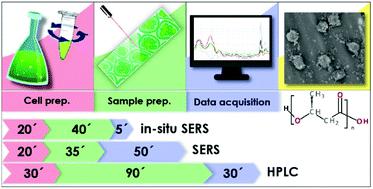Our official English website, www.x-mol.net, welcomes your feedback! (Note: you will need to create a separate account there.)
In situ based surface-enhanced Raman spectroscopy (SERS) for the fast and reproducible identification of PHB producers in cyanobacterial cultures.
Analyst ( IF 4.2 ) Pub Date : 2020-07-02 , DOI: 10.1039/d0an00969e Daniel-Ralph Hermann 1 , David Lilek , Christina Daffert , Ines Fritz , Simone Weinberger , Vanessa Rumpler , Birgit Herbinger , Katerina Prohaska
Analyst ( IF 4.2 ) Pub Date : 2020-07-02 , DOI: 10.1039/d0an00969e Daniel-Ralph Hermann 1 , David Lilek , Christina Daffert , Ines Fritz , Simone Weinberger , Vanessa Rumpler , Birgit Herbinger , Katerina Prohaska
Affiliation

|
The production of polyhydroxybutyrate (PHB) by autotrophic fermentation of cyanobacteria has received increasing interest in the light of carbon emission reducing process strategies. Biotechnological approaches are in development to optimize the yield of PHB, including adapted cultivation media, characterized by a limitation of key nutrients: cyanobacteria accumulate PHB as energy storage molecules under limited growth conditions. Since there is an increasing demand for fast, simple and reliable analytics, we report the establishment of surface enhanced Raman spectroscopy (SERS) as a suitable monitoring tool for up scaled PHB production processes. Both, pure Ag-colloids mixed with bacterial culture, and in situ prepared colloids (Ag-Synechocystis), generated on the cell surface directly, were successfully applied and evaluated for this purpose. SERS measurements with in situ prepared Ag-colloids improved the reproducibility of Raman signals from 54.8% to 93.9%. The measurement time could be reduced significantly, completing our secondary goal. The quality of classically and in situ prepared Ag-colloids was monitored by zeta potential measurements and scanning electron microscopy (SEM) respectively. For data interpretation and statistical model-building an in house written code in the open source software RStudio was implemented. It was applied for the differentiation of PHB producers at the cellular level, revealing heterogeneities within sample groups regarding the PHB amount accumulated. The results obtained using the statistical model were validated as well and were complementary to the reference HPLC analysis. Therefore, a fast and reliable identification in situ SERS tool for the selection of the most promising cyanobacterial PHB production was established.
中文翻译:

原位表面增强拉曼光谱 (SERS) 用于快速、可重复地鉴定蓝藻培养物中的 PHB 生产者。
鉴于减少碳排放的工艺策略,通过蓝藻自养发酵生产聚羟基丁酸酯(PHB)越来越受到人们的关注。生物技术方法正在开发中,以优化 PHB 的产量,包括适应的培养基,其特点是关键营养素的限制:蓝藻在有限的生长条件下积累 PHB 作为能量存储分子。由于对快速、简单和可靠的分析的需求不断增加,我们报告了表面增强拉曼光谱 (SERS) 的建立,作为大规模 PHB 生产过程的合适监测工具。为此目的,纯银胶体与细菌培养物混合,以及原位制备的胶体(银集胞藻)直接在细胞表面生成,均已成功应用和评估。使用原位制备的银胶体进行SERS 测量,将拉曼信号的再现性从 54.8% 提高到 93.9%。测量时间可以显着减少,完成我们的第二个目标。分别通过 zeta 电位测量和扫描电子显微镜 (SEM) 监测经典和原位制备的银胶体的质量。为了进行数据解释和统计模型构建,在开源软件 RStudio 中实施了内部编写的代码。它用于在细胞水平上区分 PHB 产生者,揭示样本组内有关 PHB 积累量的异质性。使用统计模型获得的结果也得到了验证,并且与参考 HPLC 分析相补充。因此,建立了一种快速可靠的原位SERS 鉴定工具,用于选择最有前途的蓝藻 PHB 生产。
更新日期:2020-07-30
中文翻译:

原位表面增强拉曼光谱 (SERS) 用于快速、可重复地鉴定蓝藻培养物中的 PHB 生产者。
鉴于减少碳排放的工艺策略,通过蓝藻自养发酵生产聚羟基丁酸酯(PHB)越来越受到人们的关注。生物技术方法正在开发中,以优化 PHB 的产量,包括适应的培养基,其特点是关键营养素的限制:蓝藻在有限的生长条件下积累 PHB 作为能量存储分子。由于对快速、简单和可靠的分析的需求不断增加,我们报告了表面增强拉曼光谱 (SERS) 的建立,作为大规模 PHB 生产过程的合适监测工具。为此目的,纯银胶体与细菌培养物混合,以及原位制备的胶体(银集胞藻)直接在细胞表面生成,均已成功应用和评估。使用原位制备的银胶体进行SERS 测量,将拉曼信号的再现性从 54.8% 提高到 93.9%。测量时间可以显着减少,完成我们的第二个目标。分别通过 zeta 电位测量和扫描电子显微镜 (SEM) 监测经典和原位制备的银胶体的质量。为了进行数据解释和统计模型构建,在开源软件 RStudio 中实施了内部编写的代码。它用于在细胞水平上区分 PHB 产生者,揭示样本组内有关 PHB 积累量的异质性。使用统计模型获得的结果也得到了验证,并且与参考 HPLC 分析相补充。因此,建立了一种快速可靠的原位SERS 鉴定工具,用于选择最有前途的蓝藻 PHB 生产。



























 京公网安备 11010802027423号
京公网安备 11010802027423号